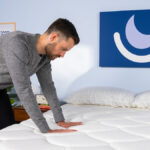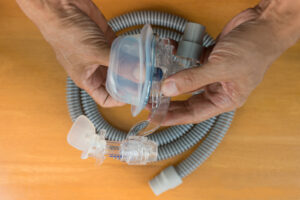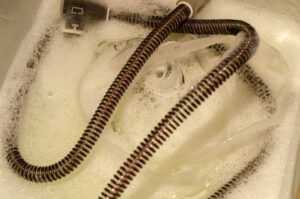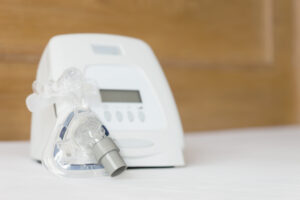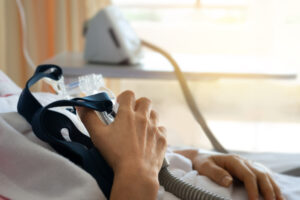Positive airway pressure (PAP) therapy is the most effective non-surgical treatment for moderate to severe sleep apnea. These medical devices are FDA prescribed and require a prescription from a medical professional.
There are several types of PAP therapy available, including continuous positive airway pressure (CPAP). While some machines can provide different types of airflow depending on your breathing needs, there are many ways to customize your machine to your personal needs. Your doctor can help you find the right masks, pillows, and hoses as well as recommend trying a different CPAP machine entirely. Because these machines work best when they are used consistently, finding the right machine and equipment is important.
CPAP
CPAP machines are typically the first line of treatment for obstructive sleep apnea (OSA).
CPAP machines are designed to deliver a constant level of pressure to the airways while you sleep. This flow of air prevents the tissues in your airways from collapsing during sleep, allowing for continuous breathing and also functioning as an anti-snoring device. Some CPAP machines include a pressure relief setting to slightly relieve pressure during exhalation.
Traditional CPAP machines are usually the most affordable and widely available type of PAP device. However, models with more components can be more expensive.
If you are newly diagnosed, your doctor will likely prescribe a CPAP machine and see how you respond. When going through your insurance provider, they may stipulate that you use a certain brand, which can limit your options. Ordering directly from the CPAP manufacturer or through a third-party retailer gives you the most options, but generally requires paying out of pocket and submitting a reimbursement claim to your insurance company.
BiPAP
Bilevel positive airway pressure (BiPAP) is one of the most popular types of PAP therapy devices. While CPAP machines work by providing a continuous steady flow of air throughout the night, the BiPAP machine works by providing two different air pressures, one for breathing in and another, lower pressure level for breathing out.
A BiPAP machine can sense when you inhale and exhale and tend to be more comfortable to use than CPAP machines. BiPAP therapy is often recommended for people with complex sleep related breathing disorders or issues. Because this is a more advanced type of PAP machine, it is also more expensive.
A doctor usually only prescribes BiPAP treatment for people with OSA if they do not respond to traditional CPAP therapy. Since BiPAP machines use two different pressure settings, an overnight titration study may be required to determine the right levels of pressure for your device.
APAP
APAP machines, also referred to as auto-CPAP, can raise or lower the pressure based on your breathing patterns. This is often more comfortable for restless sleepers, allergy sufferers, and those who had difficulty tolerating CPAP air flow.
The biggest difference between APAP and CPAP is their pressure settings. As you sleep, the APAP machine can increase pressure when it senses a respiratory event. However, they are also usually more expensive than traditional CPAP machines because of their advanced features.
EPAP
Expiratory positive airway pressure (EPAP) devices contain two valves that are inserted into the nostrils. Designed to allow a sleeper to breathe in as they normally would, the valves create resistance as the sleeper breathes out. This pressure makes the airway less likely to become narrowed or obstructed on the next inhaled breath.
EPAP therapy may help a user have fewer nighttime awakenings, reduced snoring, and fewer OSA-related lapses in breathing during sleep. However, additional studies need to be conducted for researchers to know how EPAP compares to CPAP and other available treatments for sleep apnea.
Travel CPAP
Traditional CPAP machines are quite difficult to transport. Today, there are portable CPAP machines, called travel CPAP.
Smaller and more compact, travel CPAP machines allow you to continue therapy even as you change locations. These machines still include a motor, CPAP hose, and CPAP face mask. Keep in mind that for these smaller, portable machines you should get spare batteries, as well as voltage adaptors, if you are traveling internationally.
Unfortunately, travel CPAP machines are not typically covered by health insurance. Secondly, many portable CPAP machines do not come with some of the built-in features that the larger machines have and should not be used long-term.
CPAP Supplies
PAP machines are an effective way to treat sleep apnea if they are used nightly. Finding the right machine, as well as well-fitted equipment, increases the likelihood that you will consistently use the machine.
A well-fitted mask that is the right size for you and which is tightened comfortably will prevent leaking, and ensure that you are getting an adequate amount of air. Common mask types include a nasal pillow mask, a nasal mask, and a full-face mask. Each mask works better for different types of sleepers.
All CPAP machines require accessories and additional equipment that can ease the process of getting used to your machine. These can include:
- Masks
- Mask cushions and sealers
- Air filters
- Humidifier
- Tubing
Those who use larger CPAP machines may want to use a bedside CPAP table or one of the many CPAP nightstands available to store the machine in.
All PAP therapy machines also require regular cleaning and maintenance to avoid bacteria growth and respiratory infections. You can buy manufacturer approved cleaning solutions or you can clean by hand with warm water and soap. Be careful when taking apart your device and always consult with your doctor before adjusting any of the settings of your device.
FAQs
A CPAP machine is used to treat sleep apnea, in particular, obstructive sleep apnea. It allows for continuous breathing and prevents repeated periods of halted breathing during the night. There are several types of CPAP machines depending on your needs and budget.
Since CPAP machines are class II machines, they require prescriptions from a medical professional. A doctor or sleep specialist can help you find the right type and fit for your specific needs.
If you are a side sleeper, then finding a mask that fits is important. Side sleepers often benefit from using a nasal pillow mask to avoid air leakage. In addition to a nasal pillow mask, many side sleepers use a special CPAP pillow that accommodates the device and can help them sleep more easily on their side.
References
Ask the Sleep Doctor
Have questions about sleep? Submit them here! We use your questions to help us decide topics for articles, videos, and newsletters. We try to answer as many questions as possible. You can also send us an email. Please note, we cannot provide specific medical advice, and always recommend you contact your doctor for any medical matters.
